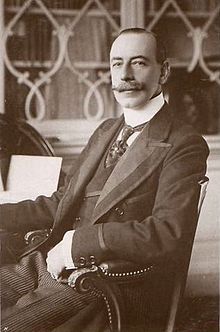Lewis Vernon Harcourt, 1st Viscount Harcourt
|
The Right Honourable The Viscount Harcourt PC |
|
|---|---|

Lewis Harcourt MP
|
|
| First Commissioner of Works | |
|
In office 10 December 1905 – 3 November 1910 |
|
| Monarch |
Edward VII George V |
| Prime Minister |
Sir Henry Campbell-Bannerman H. H. Asquith |
| Preceded by | The Lord Windsor |
| Succeeded by | The Earl Beauchamp |
|
In office 25 May 1915 – 10 December 1916 |
|
| Monarch | George V |
| Prime Minister | H. H. Asquith |
| Preceded by | The Lord Emmott |
| Succeeded by | Sir Alfred Mond, Bt |
| Secretary of State for the Colonies | |
|
In office 3 November 1910 – 25 May 1915 |
|
| Monarch | George V |
| Prime Minister | H. H. Asquith |
| Preceded by | The Earl of Crewe |
| Succeeded by | Bonar Law |
| Personal details | |
| Born |
31 January 1863 Nuneham Courtenay, Oxfordshire |
| Died |
24 February 1922 (aged 59) Brook Street, London |
| Nationality | British |
| Political party | Liberal |
| Spouse(s) | Mary Ethel Burns (m. 1899-1922; his death); 4 children |
Lewis Vernon Harcourt, 1st Viscount Harcourt, PC (born Reginald Vernon Harcourt; 31 January 1863 – 24 February 1922) was a British Liberal Party politician who held the Cabinet post of Secretary of State for the Colonies from 1910 to 1915. Lord Harcourt's nickname was "Loulou".
Harcourt was born at Nuneham Courtenay, Oxfordshire, the only surviving son of politician Sir William Vernon Harcourt and his first wife Theresa Lister. He was originally christened with the name Reginald, in honour of his father's university friend Reginald Cholmondeley, but when George Cornewall Lewis died just over two months after, he was rechristened with the name Lewis. He never knew his mother who died only a day after giving birth to him. His elder brother, Julian Harcourt, had died the previous year. He was educated at Eton.
He inherited the lordships of the manor of Stanton Harcourt, Nuneham Courtenay, North Hinksey, Coggs, Northmoor and Shifford in Oxfordshire. He was also a Knight of Malta.
Harcourt was private secretary to his father, Sir William, as Home Secretary from 1880 to 1885. He was Liberal Member of Parliament for Rossendale, Lancashire, from 1904 to 1916 and served as First Commissioner of Works in Sir Henry Campbell-Bannerman's 1905 ministry (appointed to Cabinet in 1907) and to H. H. Asquith's Cabinet between 1908 and 1910 and again between 1915 and 1916. In this role he authorised the placement in Kensington Gardens of the Peter Pan statue, sculpted by George Frampton, erected on 1 May 1912.
...
Wikipedia
